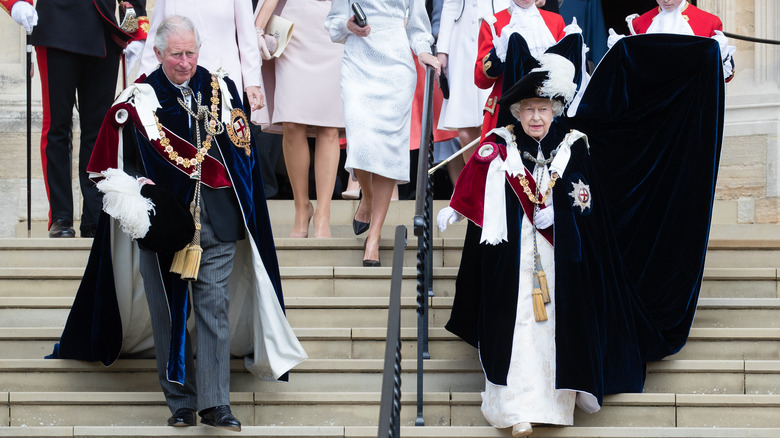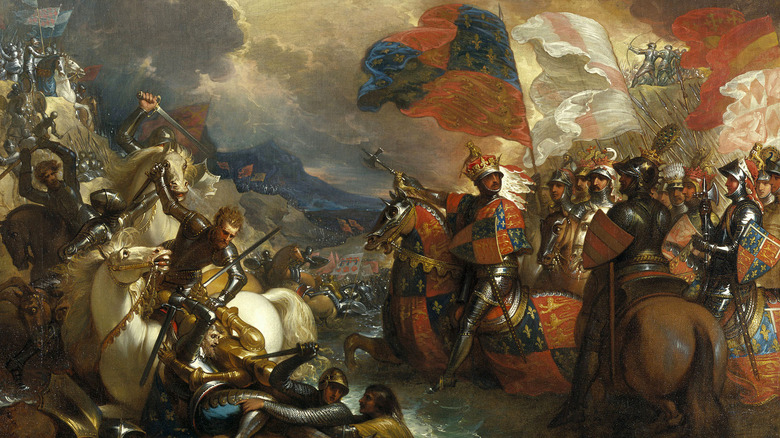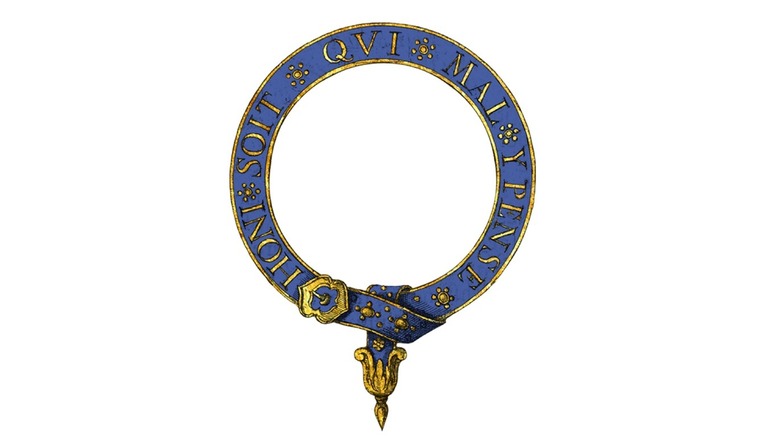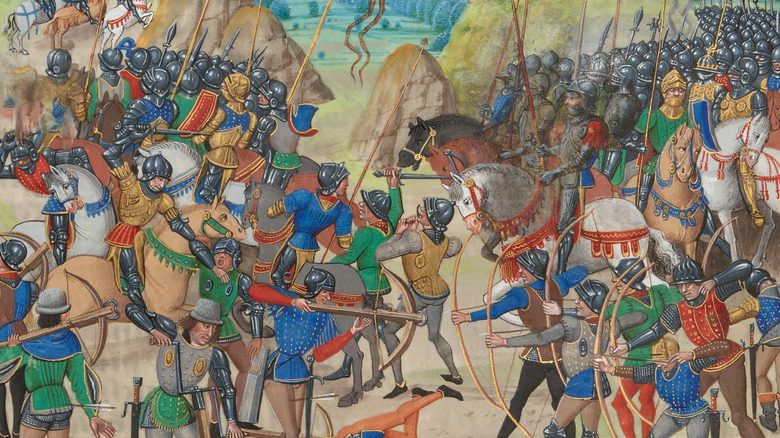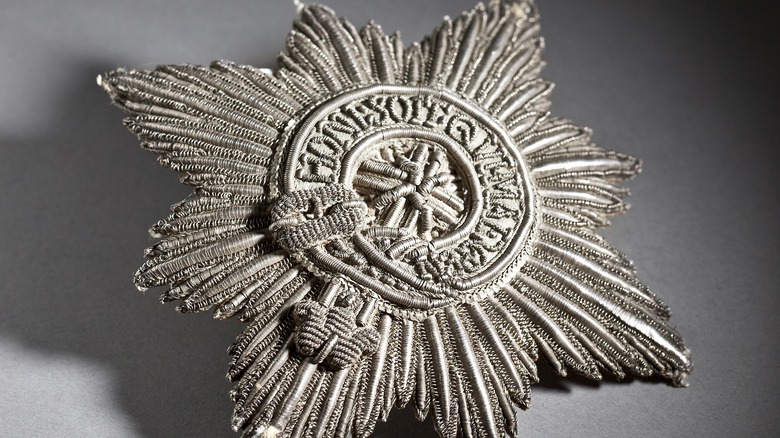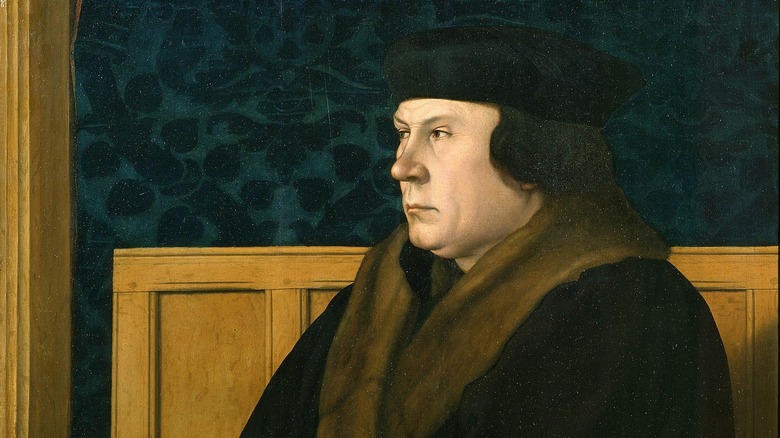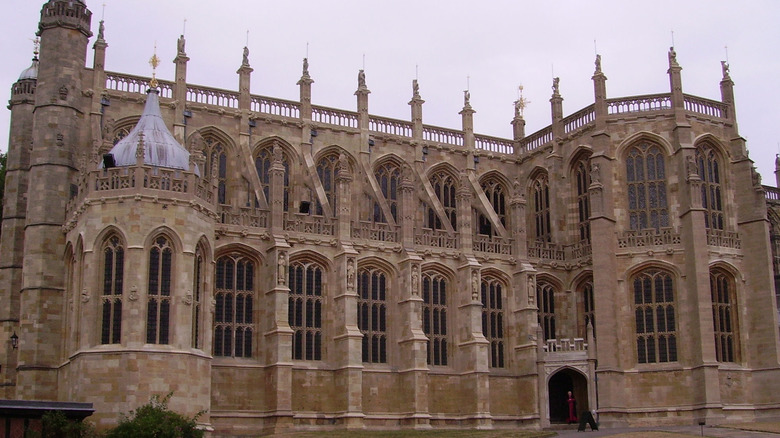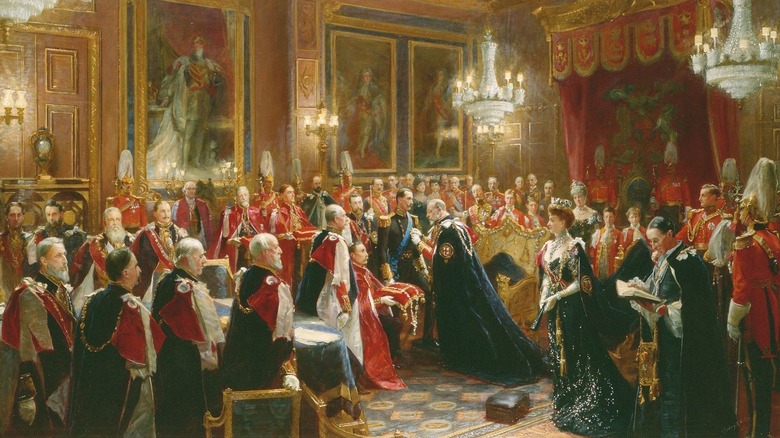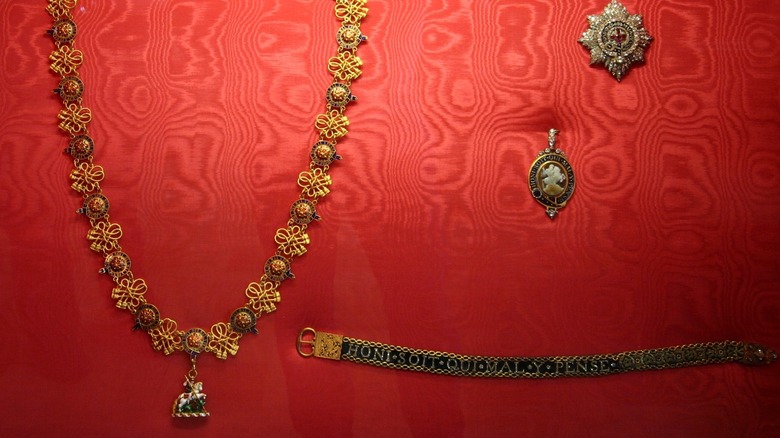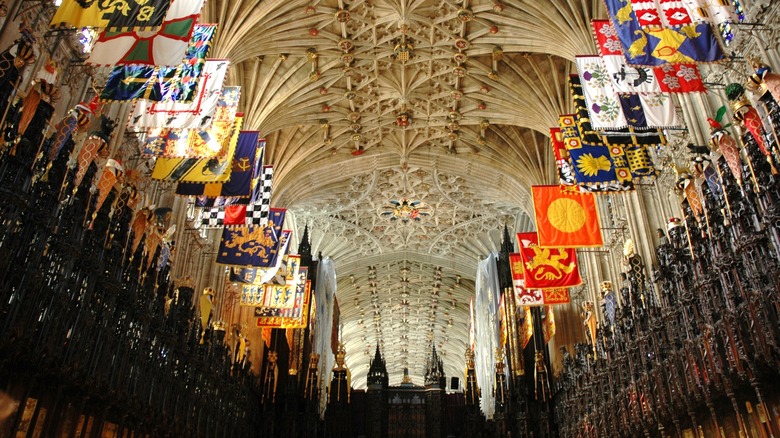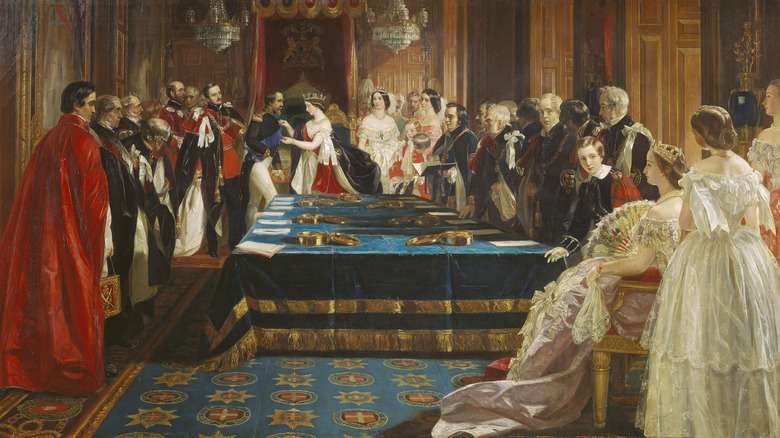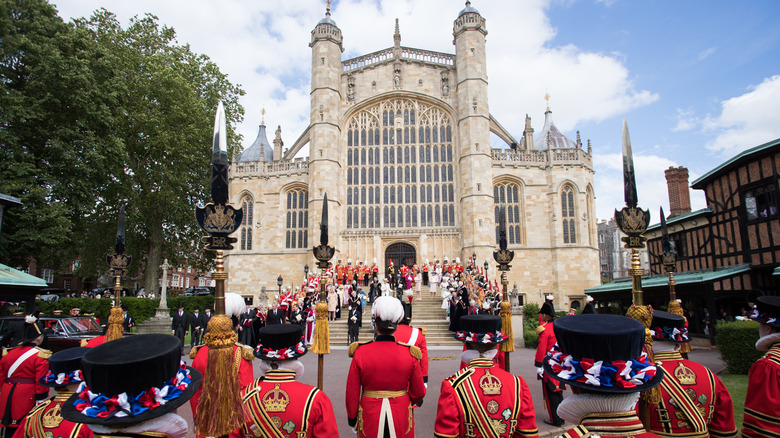Britain's Order Of The Garter Explained
If you aren't a knight, wouldn't it be awesome to be one? You get to have the cool honorific Sir or Dame. You can wear clothes worthier than what you see at a Renaissance Faire. You also are required to have a heraldic badge that will help you emulate the ideals of chivalry expressed by King Arthur and his Knights of the Round Table. Albeit this is a more upscale version than the original version.
Of the various chivalric orders, the Order of the Garter is the oldest and the most illustrious. Named directly by the British monarch, the order conveys a status and cache that is unparalleled. Yet most people don't know a thing about the Order of the Garter. What are its origins? What do these companions (as they are called) do? How do you get in? And why on earth does it use a garter for a knightly symbol.
For those of you thirsting to learn more about this noble order, fear not! Here's Britain's Order of the Garter explained.
Edward III created the Order of the Garter
Edward III, king of England and lord of Ireland, ruled, according to the BBC, from 1327 until his death in 1377. His 50-year reign was marked by the start of the Hundred Years' War in which he claimed the throne of France. He and his son, Edward the Black Prince, saw victory over the French at several victories, including the Battle of Crécy in 1346 where the English decimated the French.
Several sources, including "King Arthur's Round Table," explain that Edward III was inspired by the English mythology of King Arthur and his knights. In 1344 the king said that he wished "to found a Round Table in the same manner and form as the Lord Arthur once King of England had established it ..."
In 1348, flush with victory over the French, the king established the Order of the Garter. He was to be Arthur, and those in the Order were to be his knights of the Round Table. As told by historian Nigel Saul, Edward III wanted the same mystical auror to his dynasty of not only Arthur but also St. George the dragon slayer. Windsor Castle was to be a new Camelot. While Edward never became a new Arthur, his Order of the Garter did become the most distinguished form of knighthood from British history.
Legends developed to explain why a garter became a knightly symbol
The Order of the Garter is called so because their symbol is, well ... a garter. Why a garter? There are competing theories. One popular account tells how when the countess of Salisbury was at an assembly at Windsor Castle, a blue garter slipped off her leg and fell to the floor. Scandalized by mocking courtiers, the countess fell into embarrassment, but the king picked up the garter, buckled it to his knee, and said, "Honi soit qui mal y pense," meaning "shame on any who think evil of this." This became the motto of the Order of the Garter. Historic UK goes on to speculate that even in medieval times dropping a garter should not have been so scandalizing. They offer that garters were used as a symbol of witchcraft, and the king was merely saving the countess from accusations.
However, these explanation seem apocryphal and sort of silly. According to the "Sixteenth Century Journal," the symbol was solidified for posterity when Edward the Black Prince gifted 24 garters to knights of the new order, leading to an official inception date of April 23, 1348. This day has symbolic importance since it is St. George's Day, and St. George became the patron of the order.
The Garter Symbolizes English Dominance Over France
A more plausible theory as to where the garter came from is offered by a 19th century reference work. Edward III used his garter as a signal at the Battle of Crécy. Men regularly wore garters at that time, according to Fordham University, and they were used to hitch armor. It is possible that the story of the countess developed later, in response to puzzlement as to why a female fashion accessory was chosen as the order's symbol.
When Edward III established the order, he allowed for 26 knights (including himself and his son, the Black Prince), called companions, to be chosen for it. As emphasized by the Oxford Dictionary of National Biography, it was limited, exclusive, and meant to signify great honor. Many, if not all of those chosen to be knights in this initial group were companions in arms from the war in France. At least 18 were at the Battle of Crécy. All of these men had relationships with Edward III or his son.
To cement this fellowship, "King Arthur's Round Table" describes how the king had a large round table installed at Windsor Castle. To emphasize his claim on the throne of France, the garter took on the traditional colors of France, blue and gold. This leads one to believe that the motto, "Shame on him who thinks badly of it" (another translation) really comes from Edward III's campaigns against the French and his claims to the French throne.
What does the Order of the Garter do?
Taking Edward III's fascination with King Arthur and his Knights of the Round Table into account, it is reasonable to assume that being a Knight of the Order of the Garter would be exciting. Perhaps a Knight of the Garter would face more quests than if J.K. Rowling met the ghost of J.R.R. Tolkien and wrote a mash up. Unfortunately, questing isn't quite the duties performed by the Order of the Garter. In fact, the whole thing is honorific.
As Historic UK details, the Order of the Garter is considered the third most prestigious honor in the United Kingdom. Only the Victoria Cross and the St. George's Cross take precedence over it. The Order of the Garter is, however, the most prestigious chivalric order in the country. Those who are in it carry the letters KG (Knight of the Garter) or LG (Lady of the Garter) at the end of their name, says Royal UK.
As far as can be told, members of the order today have performed all their major accomplishments and received the honor for their lifetime of work. It seems that the only requirement is to show up at the annual Garter Day procession in June.
How to Get Kicked Out of the Order of the Garter
By the 16th century, commoners of exceptional talent joined the order. The College of St. George explains how the common-born Thomas Cromwell had become Lord of the Privy Seal under King Henry VIII. Cromwell was important to the king since he finagled a divorce for him from his first wife, Catherine of Aragon, so he could marry Anne Boleyn. Cromwell was duly inducted into the order in 1537. However, Henry VIII's second marriage didn't work out — Boleyn was beheaded. Nor his next one — she died. Thus, Cromwell played matchmaker and set up the king with his fourth wife, Anne of Cleves.
The good times didn't last for Cromwell. The marriage with Anne of Cleves didn't work out either, and Cromwell was blamed for it. Cromwell was ejected from the Order of the Garter in a process called degradation. His arms, helmet, crest, and anything else of his in the Chapel of St. George was thrown violently down and kicked out of the chapel, then booted through the lower ward and right into the castle ditch. On the lists that record members of the order, the words vah proditor, meaning "Fie on you, traitor," remain branded forever next to Cromwell's name. Cromwell was executed in 1540.
Cromwell was the first to be punished in such a way. St. George's College reports that there have been a total of 40 knights who have undergone degradation for a variety of reasons.
The Order of the Garter was a men's only club until Elizabeth II
The Order of the Garter has had an on-again, off-again, on-again relationship with women. Edward III, according to St. George's College, believed that women should be associated with it. Ladies served as objects inspiring knights and took part in festivities. These were known as "Ladies of the Garter" and were normally of royal blood or of close kin to the knights. While officially these ladies were not in the order as companions, there is some evidence to suggest that they may have been given the garter to wear as an honor since it is seen in images in their tombs.
King Henry VII, the first king of the Tudor Dynasty, was the last king to name Ladies of the Garter during his reign in the late 15th and early 16th centuries. Then in 1901, Edward VII named his wife Queen Alexandra to the order. Other women through the 20th century were named as supernumerary Order of the Garter associates, but it wasn't until 1987 when Queen Elizabeth II ordered by Garter Statute that women would join the Order of the Garter as "Lady Companions of the Order" to be of equal status to knights. This, as quoted by the "Sixteenth Century Journal, was "... to do away with sex discrimination." Lavinia, the duchess of Norfolk was the first to be inducted fully into the order in 1990.
St. George's Chapel is the Order of the Garter's Spiritual Home
The spiritual heart of the Order of the Garter is St. George's Chapel at Windsor Castle. The chapel, as described by St. George's College, was originally dedicated to St. Edward the Confessor when it was built by Henry III in the early 13th century. In 1348, Edward III rededicated to the Virgin Mary and St. George. With the renaming came a large renovation. The result, as explained by Britannica, became a notable example of the perpendicular style of Gothic architecture.
Of particular importance in its design is the quire or choir area where aside from the choir, clergy sat. In this section there are a series of oak stalls complete with elaborate canopies. Each stall was and is identified with a particular companion being named with a brass plate. To further emphasize the connection of the chapel with the Order of the Garter, St. George's College explains how the quire also displays the banners of the currently living companions.
The chapel and stalls were built with the expectation that a companion could make as offering his or her crest, sword, and helmet to God. These became part of the yearly rituals at the Requiem Mass for Deceased Companions, which offers these items of all deceased knights. These items become property of the college, but spiritually, the meaning is that the offering is that of the accomplishments of that knight or lady.
Royal family members are allowed into the Order of the Garter
The Order of the Garter today is in structure much the same as it had been in Edward III's time. As described by Britannica, there are 24 knights or ladies who are appointed by the monarch with the sovereign and the prince of Wales added. There are some key differences, however. Originally, when there came a vacancy in the order, the living knights elected new knights to fill the vacancies. "Medieval Prosopography" reports that the new companions were selected based on their military abilities. This emphasis faded, and eventually the power of appointment shifted entirely to the monarch.
The order also has five officers. The prelate doubles as the bishop of Winchester. There is also a chancellor, garter king of arms, registrar, and gentleman usher of the black rod. Oxford Reference notes that this last position is also responsible for maintaining order in the House of Lords, presumably with his black rod.
The Order of the Garter also has numerous supernumeraries. These are persons who are associated with the order but are not part of the designated 24. For example, by the early 19th century, members of the royal family were admitted as Royal Knights Companions.
Great George and Lesser George
When companions of the Order of the Garter are in full regalia they make for a dashing sight. Sotheby's shows how ostrich plumed floppy caps and velvety robes are for those special occasions when members of the order need to be a little showy. There are also numerous symbols associated with the order. The most well-known is the blue garter that bears the order's motto. On men, it is worn on the left leg below the knee. Women companions, according to St. George's College, wear a corded silk garter complete with gold embroidery and pendant on the left arm.
There is also a collar, which is an elaborate chain with gold knots with heraldic designs and symbols. Most prominent is a pendant depicting St. George slaying a dragon. This is called the Great George. There is also a second badge depicting St. George encircled by a garter. This is worn under the right arm and is called the Lesser George. Then there is the garter star, a white star with the cross of St. George, which is to be worn when not wearing their robes.
All this garb, as described by "The Elizabeth II Pocket Bible," are returned upon the death of a companion.
Garter Day is the annual knightly confab
The most visible activity of the Order of the Garter occurs on Garter Day in June. According to the Royal Family website, all the knights and ladies of the order come in full, robed regalia and start the day in the Windsor Castle throne room where the sovereign formally invests new members in a private ceremony. This includes any of the 24 spots that may be open and also any supernumeraries.
A lunch is then held, followed by a procession led by a marching band to St. George's Chapel. The way is lined by security and ceremonial soldiers, such as the beefeaters and yeoman guards. The companions hold a short service where new companions are installed into their stalls before departing by carriage or car. This procession may be viewed by the public, but the limited number of spaces means that applications must be sent months in advance. Sadly, Garter Day ceremonies in 2020 and 2021 were canceled due to the coronavirus pandemic.
An Investiture Ceremony of a Companion of the Garter
Perhaps the coolest part of the Order of the Garter is the investiture ceremony. The College of St. George describes the ceremony as extremely formal. The knight-to-be either sets his foot on a stool or kneels. The monarch then takes the blue garter and fastens it to the knee (in men) or on the elbow (in women). The chancellor then makes a pronouncement, which emphasizes the martial origins of the order — "To the Honour of God Omnipotent, and in Memorial of the blessed Martyr St. George, tie about thy leg, for thy renown, this Most Noble Garter; wear it as the symbol of the Most Illustrious Order never to be forgotten or laid aside, that hereby thou mayest be admonished to be courageous, and having undertaken a just war, into which thou shalt be engaged, thou mayest stand firm, valiantly fight, courageously and successfully conquer." The order's riband is then placed on followed by more flowery admonitions.
A companion of the garter also needs to take an oath to "loyally to keep and observe the statutes of the said Order as far as within his loyal ability he is able." After thanking the sovereign congratulations follow.
The Order of the Garter sounds great, where do I sign up?
As you may have guessed by now, vacancies for the Order of the Garter aren't exactly posted on Indeed.com. Being that there are only 24 available slots, it is one of the most exclusive clubs in the world. Only the queen or king of Britain can name a person to the order, and these people are almost invariably appointed due to long years of public or military service. In 2019, for example, Royal Central reported that Queen Elizabeth II appointed two companions — Mary Peters, a gold medal pentathlete who has gone on to help young people in sport through her foundation, and Robert Gascoyne-Cecil, marquess of Salisbury, who was chairman of the Thames Diamond Jubilee Foundation known for charitable work.
As such, it is no wonder that most members tend to skew older, with the youngest currently being Alan Henry, viscount of Brookeborough, who according to Cracrofts Peerage turns 69 in 2021. Thus, the Order of the Garter is a capstone to a lifetime of achievement. So if you wish to be considered, you best stop reading this article and get cracking.
